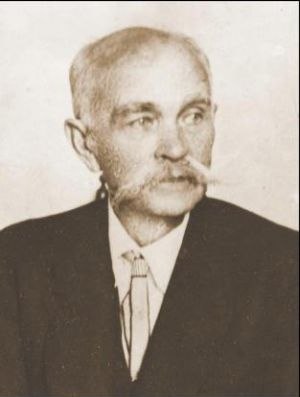SERHII SVYRYDOVYCH HAMCHENKO
 HAMCHENKO SERHII SVYRYDOVYCH (1860–1932) – military man, archaeologist, monument guardian, museologist. He devoted his life to a military career (general by order) and science, gaining recognition as an archaeologist, successfully combining service in the army (until 1918) with scientific and museum activities. For almost 50 years, he studied ancient history, researched archaeological sites and carried out activities to protect the archaeological heritage in Ukraine.
HAMCHENKO SERHII SVYRYDOVYCH (1860–1932) – military man, archaeologist, monument guardian, museologist. He devoted his life to a military career (general by order) and science, gaining recognition as an archaeologist, successfully combining service in the army (until 1918) with scientific and museum activities. For almost 50 years, he studied ancient history, researched archaeological sites and carried out activities to protect the archaeological heritage in Ukraine.
In his younger years he passed a good archaeological school under the guidance of V.B. Antonovych, a professor at the Kyiv Imperial University of St. Volodymyr. The knowledge of ancient history was strengthened by lectures of the professor of the Moscow university, the well-known historian V.O. Kliuchevskyi. During his service in the north of the Russian Empire S.S. Hamchenko received a higher civilian education – he graduated from the St. Petersburg Archaeological Institute and defended his thesis “Dune Neolithic sites on the shores of the Finland Gulf” (study of Sestroretsk mounds near St. Petersburg, 1908). Natural abilities in exact sciences, topography, drawing, military artillery practice – reflected in the materials of field research, drawings, plans of places and monuments, maps. Observations during explorations and excavations are quite scrupulous and specific. The field reports are extremely thorough and meet the requirements of the time for the excavation and fixation of archaeological sites. Publications of exploration and excavation results met the requirements of the time.
The first archaeological expedition of S.S. Hamchenko was the excavations led by V.B. Antonovych of the Drevlians burial mound in the suburbs of Zhytomyr – Maliovanka village (1878). In 1899, finds from this necropolis (silver and bronze jewelry, wire rings, belt buckles, knives, etc.) were displayed at an exhibition prepared for the XI Archaeological Congress in Kyiv. S.S. Hamchenko received the first Archaeological Excavations Permit letter that allowed him independently investigate archaeological monuments in 1886. The first archaeological monograph was “Zhytomyr necropolis. Archaeological research of the Zhytomyr group of mounds” (1888) – received support and positive feedback from such scientists as O.O. Bobrynskyi and K.V. Bolsunovskyi. In particular, the emphasis was placed on the significance of S.S. Hamchenko’s search for Volhynia, where they became in fact the first significant systematic archaeological research. Professor V.B. Antonovych assessed the work of his junior colleague as a work “quite scientific, largely conducive to a scientific explanation of our prehistoric antiquity.”
To the XI Archaeological Congress in Kyiv (1899) Serhii Hamchenko prepared an essay «Excavations of mounds near Myropil city in the basin of the Sluch River», which was read by V.B. Antonovych. In 1909, the Imperial Archaeological Commission raised the question of studying the nature of Trypillia sites and instructed S.S. Hamchenko as «one of the experienced Russian archaeologists» to conduct research on the Southern Bug River (Baltic, Olhopol, Bratslav districts of the Podilsk province). In 1909–1913, the scientist excavated about 45 new monuments, most of which belonged to the Trypillia culture, and came to the conclusion about the residential nature of the sites.
During military service (1881–1918) S.S. Hamchenko excavated Zhytomyr burial mounds and necropoleis along the banks of the Teteriv, Kamianka, and Huiva rivers, settlements along the Korchuvata and Sluch rivers, and the Stuha tract near Studenytsia village (1892), cremation mounds near Psyshchi and Kroshnia villages (1895), Ochakiv in the South of Ukraine (1903), etc. On behalf of the Imperial Archaeological Commission, the Imperial Russian Archaeological Society and other institutions, S.S. Hamchenko conducted excavations and explorations in Kyiv, Volyn, Podillia, Kherson, Odesa, Bessarabia, etc. During this productive period of S.S. Hamchenko’s activity he was elected a corresponding member of the Kyiv Society of Antiquities and Arts (1902), a full member of the Historical Society of Nestor the Chronicler, a full member of the Imperial Russian Archaeological Society (March 29, 1907), a member of the St. Petersburg Institute of Archaeology. (1913) and the Kazan Society of History and Antiquities.
Until the end of life, S.S. Hamchenko did not sever ties with Zhytomyr. On May 31, 1899, the General Assembly of the Volyn Provincial Statistical Committee elected S.S. Hamchenko a full member. He was also one of the founders of the Society of Researchers of Volyn (1901), made a speech at its first meeting about the tasks of the Society in the study of the archaeological past of the region and identified areas of work. He later became a member and a chairman of the Bureau of the Volyn Section of Researchers (1923–1927), and worked as the head of the Archaeological department of the Volyn Research Museum in Zhytomyr (1919–1927).
In 1927 S.S. Hamchenko moved to Kyiv, where he joined the cooperation with the institutions of the All-Ukrainian Academy of Sciences (the AUAS), in particular the work and activities of the All-Ukrainian Archaeological Committee (the AUAC) – excavations, explorations, conferences, exhibitions, articles, publications. He was elected a full member of the AUAC (1927), a full member of the Trypillia Commission of the AUAC and the Commission for the Study of the Grand Duchy of Kyiv, Vice-President of the AUAC of the AUAS (1928) and head of its Archaeological department (since 1927). The Plenum of the Committee for Monumental Studies of the AUAC instructed S.S. Hamchenko to draw up a long-term research plan (January 1928), in which, in particular, he proposed to take into account the professional training of researchers when receiving Archaeological Excavations Permit letters, raised the need for specialization of research on individual cultures and complexes, within certain territories and gave a thorough definition of «reconnaissance», «prospecting», «excavation». In January 1928, the scientist prepared a «Scheme of Archaeological Research in Ukraine», which provided for the assignment of archaeologists to administrative districts. These proposals took a step towards uniting researchers of antiquities around the AUAC, introduced planned excavations, and expanded thematic and organizational studies of monuments in Ukraine.
During the Kyiv period, S.S. Hamchenko led archaeological detachments that researched Trypillia monuments near Kolodiazhne (1927), Bilyi Kamin (1928), Stina, and Pechera (1928–1929) villages, on Trubetskyi’s estate in Kyiv (1926–1927), in the Izium region (1929–1930), in Tulchyn (1929–1930), etc. He took part in the work of the Dnieper Hydroelectric Station Archaeological expedition (1928). The last excavations were conducted by an archaeologist in the early 1930-ies in Bahlai village of Staro-Kostiantyniv district (now – Khmelnytskyi Region), where he researched the monuments of «burial fields» of the II-V centuries and on the Raikovets settlement.
The scientist left behind a huge scientific legacy in the form of manuscripts and printed works. They are stored mainly in the Scientific Library and Scientific Archive of the Institute of Archaeology of the NAS of Ukraine, in the Institute of Manuscripts of the National Library of Ukraine named after V.I. Vernadskyi, the State Archive of Zhytomyr Region in the fonds of Cultural Reserve «Zhytomyr Regional Museum» and others.
The Scientific Archive of the Institute of Archaeology of the National Academy of Sciences of Ukraine preserves the personal fond of S.S. Hamchenko (No. 3) for 1886–1931, which was transferred for storage by his student M.L. Makarevych. The archival collection contains scientific manuscripts on archaeological research of monuments in Ukraine and Russia, correspondence on the organization and conduct of archaeological excavations in various provinces and regions of Ukraine and Russia, official and report notes on the organization of museum work in Ukraine, the All-Ukrainian Archaeological Committee , notebooks, official documents, etc.
In the «Autobiography» S.S. Hamchenko noted that his scientific archive contains about 50 manuscripts with a volume of almost 70 printed sheets. In the manuscripts remained: «Excavations in 1909 of the Trypillia culture in Podillia» (the manuscript was transferred by the Imperial Archaeological Commission to the State Academy of the History of Material Culture), «Mound necropolis in Hremiache tract», «Burial mounds on the Huiva River», «Trypillia culture in Volyn according to excavations in 1896, 1924 and 1926», «Trypillia culture in Volyn (according to the experiments of 1927)», «Excavations of 1928 primary sources of Trypillia culture in Bilyi Kamin village in the Tulchyn region» (the last three works are intended for 2-3 issues of the «Trypillia collection of papers of the AUAC) and many others. In the manuscript there is also the work «Methodical instructions on local lore and archeology» (60 pages), where he detailed his views on the methodology of archaeological research. In the 1920-ies and 1930-ies, Serhii Hamchenko managed to unite around himself and bring up a constellation of talented students who connected their lives with archeology – I.F. Levytskyi, O.F. Lahodovska, F.A. Kozubovskyi, M.L. Makarevych.
The human fate of Serhii Hamchenko and his family in Soviet times was quite tragic. On April 6, 1923, he was registered as a «former white officer» by the Vovchanskyi Main Political Department of Kharkiv Region. The autobiographies (two are known: 1927 and 1928), compiled by the scientist while working at the All-Ukrainian Archaeological Committee of the Ukrainian Academy of Sciences, contain hiden social status (nobility received for military service), family ties (brothers Ivan, Dmytro, Yevhen Hamchenko – generals of the Russian Empire), changed year of birth, patronymic, incorrectly indicated the names of military schools, participation in the scientific Imperial Societies of Ukraine, Russia and abroad until 1921. In 1930, Serhii Hamchenko retired and finally settled in Zhytomyr, the last two years of his life he applied for an academic pension and died on October 6, 1932 during the Holodomor.
S.M. Liashko
